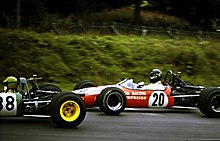



The Brabham BT21 was an open-wheel formula racing car, designed, developed, and built by Brabham in large numbers in 1966 and delivered to private individuals; 110 vehicles were manufactured.[1]
Most were manufactured as Formula 3 cars, with some built for US Formula B and given the designation 21B. The wagons for the Formule Libre ran under the identifier 21C.[2][3]
The first BT21s came to international racetracks in 1966. The chassis was flatter than the BT18, the suspension was revised and the body was completely rebuilt. In 1966 and 1967, a 997 cc (60.8 cu in) naturally aspirated Cosworth MAE four-cylinder engine with 125 hp (93 kW) and in 1968 a Holbay unit were used as engines. This drove the rear wheels through a Hewland Mk.4 five-speed manual transmission. The chassis was constructed out of a tubular space frame, with a lightweight fibreglass body. This meant the car was very light and nimble, weighing in at only 900 lb (410 kg).[4][5]
Private drivers like Peter Westbury with his Felday Engineering Ltd. had much success with the BT21 in 1967. In 1968 the BT21 became a serious opponent with the new Tecno and the victories in Formula 3 became fewer.
The BT21B, therefore, underwent some changes. The car got wider wheels and a sturdier tubular space frame derived from the BT23, a Formula 2 car. This eliminated the shortcomings. In 1969 the BT21 was slowly being replaced by the BT28.
|
| |||||
|---|---|---|---|---|---|
| |||||
|